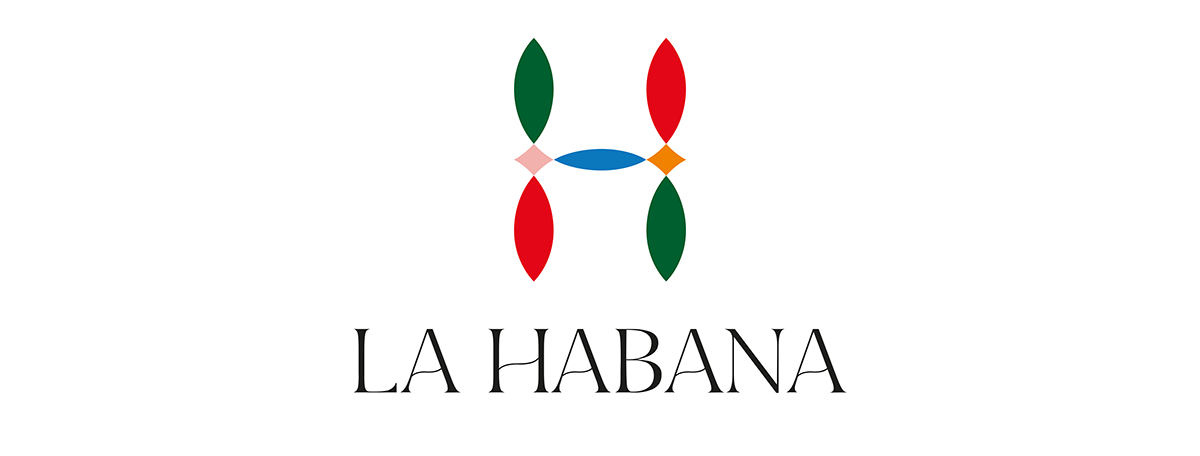Identidad visual de La Habana —Havana city visual identity
Cuba es la isla más grande de las Antillas. La Habana, su capital, la ciudad más grande de la isla, su principal puerto, centro económico, cultural y también turístico. Cuba fue una importante colonia española hasta el año 1898. A partir de la independencia, el país empezó una época dorada de bonanza. La Habana llegó a ser la quinta ciudad del hemisferio norte en ingresos per cápita, la más alfabetizada de América Latina, y con un nivel de vida superior al de España, Francia o Portugal. La dictadura de Fidel Castro congelaría el tiempo en los años cincuenta del siglo XX. Como resultado de una historia convulsa, con altibajos de gloria y una política caótica; La Habana hoy se mantiene en pie, con gran parte de la ciudad en ruinas. Por ella circulan Chevrolets del siglo pasado, de todos los colores. Los turistas van en busca de los famosos estudios de cine que ofrece la ciudad, del ballet nacional, la poesía de José Martí, el béisbol, el mojito, el Malecón, los puros Cohiba, el clima y el ron. Los cubanos levantan el país con su trabajo, en un marco de recuerdo colonial con influencias africanas.
Cuba is the largest island in the Antilles. Havana, its capital, the largest city on the island, its main port, economic, cultural and also tourist center. Cuba was an important Spanish colony until 1898. After independence, the country began a golden age. Havana became the fifth city in the northern hemisphere in income per capita, the most literate in Latin America, and with a standard of living higher than that of Spain, France or Portugal. The dictatorship of Fidel Castro would freeze time in the fifties of the 20th century. As a result of a troubled history, with ups and downs of glory and chaotic politics; Havana today remains standing, with much of the city in ruins. Chevrolets of the last century circulate through the city. Tourists go in search of the famous film studios that the city offers, the national ballet, the poetry of José Martí, the baseball, the mojito, the Malecón, the Cohiba cigars, the weather and the rum. Cubans raise the country with their work, in a framework of colonial memory with African influences.
01. Logo


02. Iconografía — Icons

En este proyecto intento transmitir La Habana que conozco: colorida y vital como África; elegante y refinada como Europa; vibrante y melancólica como ninguna.
In this project I try to convey the Havana that I know: colorful and vital like Africa; elegant and refined like Europe;vibrant and melancholic like no other.
Tras investigar sobre la arquitectura de la ciudad y sus influencias coloniales, empecé a descubrir elementos que se repetían en los edificios, los suelos, las farolas y los monumentos de la ciudad: éstos eran arcos, columnas griegas, azulejos en mosaico, motivos geométricos, vitrales… De ese conjunto de ideas, surge el símbolo de la marca: una h formada por lágrimas y triángulos creados a partir de formas geométricas; como un mosaico de los azulejos coloniales. El logotipo que complementa al símbolo es el nombre de la ciudad con la tipografía Bon Vivant Regular - de Nicky Laatz-, en mayúsculas.
El sistema visual está formado únicamente por ilustraciones o iconos que parten de los elementos que conforman el símbolo. Combinándolos entre ellos, cortándolos, alargándolos o ensanchándolos, han nacido iconos que representan los principales atractivos de la ciudad. Para no olvidar el toque africano, he querido combinar la elegante iconografía con colores muy llamativos y vibrantes, propios de la isla.
El sistema visual está formado únicamente por ilustraciones o iconos que parten de los elementos que conforman el símbolo. Combinándolos entre ellos, cortándolos, alargándolos o ensanchándolos, han nacido iconos que representan los principales atractivos de la ciudad. Para no olvidar el toque africano, he querido combinar la elegante iconografía con colores muy llamativos y vibrantes, propios de la isla.
After investigating the architecture of the city and its colonial influences, I began to discover elements that were repeated in the buildings, floors, lampposts and monuments of the city: these were arches, Greek columns, mosaic tiles, geometric motifs, stained glass ... From this set of ideas, the symbol of the brand emerges: an h formed by tears and triangles created from geometric shapes; like a mosaic of colonial tiles. The logo that complements the symbol is the name of the city with the Bon Vivant Regular typography - by Nicky Laatz-, in capital letters. The visual system consists solely of illustrations or icons that start from the elements that make up the symbol. Combining them with each other, cutting, lengthening or widening them, icons have been born that represent the main attractions of the city. In order not to forget the African touch, I wanted to combine the elegant iconography with very striking and vibrant colors, typical of the island.
03. Lona de bienvenida a la ciudad — Welcome to the city

04. Botella de agua, bolsa de tela, gorra de béisbol y cuadernos de viaje de la ciudad — Water bottle, tote bag, baseball cap and travel journals




05. Libro fotográfico 'La Habana: Exteriores. Un recorrido por las calles históricas de la ciudad' — Photographic book 'Havana: Exteriors. A walk through the historic streets of the city'


06. Lonas promocionales de los cuatro eventos más importantes de la ciudad — Promotional banners of the four main events of the city




07. Cartel digital de bienvenida a la ciudad — Welcome digital banner


08. Diseño para la biblioteca principal de La Habana — Design for the main library of the city


¡Gracias!
Thank you for watching








